The New Strategist Journal
newstrat-wakelam
newstrat-wakelam
You also want an ePaper? Increase the reach of your titles
YUMPU automatically turns print PDFs into web optimized ePapers that Google loves.
<strong>The</strong> <strong>New</strong> <strong>Strategist</strong><br />
R. Wakelam<br />
• such engagement use active rather than passive modes of learner<br />
behaviour.<br />
• each Service continue with the current encouraging trend of introducing<br />
career models that enable selected o cers to develop indepth<br />
specialisations within relevant fields – not just within “personnel<br />
management” and “project management/technology” but also<br />
within economics, politics and military sociology. (2013, 113)<br />
Notions of ‘got here. . . get there’ seem awfully like personal mastery and perhaps<br />
mental models. <strong>The</strong>re are striking similarities with Senge’s model throughout the<br />
Australian document. <strong>The</strong>re are also striking similarities with the recommendations<br />
of the US study’s recommendation to group o cers either for operations or enterprise<br />
assignments. Perhaps most centrally we can see the wisdom of Wavell and Slim in<br />
the recognition that strategic leadership is not the same as operational and tactical<br />
acumen.<br />
A third document from 2013 captures the main themes from a pan NATO conference<br />
on military education and learning. Extracts from the report of “Connected<br />
Forces, Educated Minds: Transformation and Professional Military Education” follow.<br />
(Wilton Park 2013) From the conference report:<br />
<strong>The</strong> aim of this two day conference is to help lead the way towards a<br />
new NATO Standard for professional military education (PME). Specifically,<br />
the conference will consider PME in the light of the lessons learned<br />
from over a decade of Alliance-led operations and how best the corporate<br />
memory gained can be captured before becoming lost so that PME takes<br />
its rightful place as part of enhanced training, exercising and education<br />
in the creation of NATO Forces 2020. (2013, 3)<br />
Education will vary according to level and capability and be tailored to<br />
support careers that specialise in many security domains. For example,<br />
at the mid-level education will produce “brilliant mechanics”, whereas<br />
at the higher-level it will reinforce “strategic level intuition”. <strong>The</strong> PME<br />
system must be agile enough to recognise early and support “the likes<br />
of a Petraeus or Stavridis” as well as more modest mortals. Critically,<br />
central to PME will be a tailored, career-long learning relationship that<br />
can identify early talent and foster an elite of o cer-scholars, some of<br />
whom are sent o↵ for a time into the civilian education sector with no<br />
suggestion that their careers will be blighted as a result. (2013, 1)<br />
On a related blog site principal conference contributor Julian Lindley French<br />
wrote:<br />
To my mind education, the knowledge it is built upon and the connectivity<br />
it breeds is the missing link between NATO nations that will help<br />
the Alliance close the strategy-austerity-capability gap.<br />
NATO 2020 pre-supposes defence modernisation at a time of acute defence<br />
austerity. NATO have created both Smart Defence and the Connected<br />
Forces Initiative both of which further pre-suppose much greater<br />
synergies between capabilities and capacities. Today, value for money in<br />
defence strategy is as much about ‘human software’ as hard capability.<br />
68



